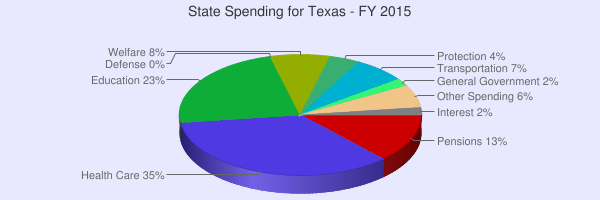4.13 国家和地方政府支出
章节大纲
-
State & Local Government Expenditures
::国家和地方政府支出Although federal government spending often gets most of the media attention, state and local government spending is also substantial—at about $3.2 trillion in 2013. 1 shows that state and local government spending has increased during the last four decades from around 10% of GDP to above 16%. The single biggest item is education, which accounts for about one-third of the total. The rest covers programs like highways, libraries, hospitals and healthcare, parks, and police and fire protection. Unlike the federal government, all states (except Vermont) have balanced budget laws, which means any gaps between revenues and spending must be closed by higher taxes, lower spending, drawing down their previous savings, or some combination of all of these.
::尽管联邦政府的支出往往得到媒体的大部分关注,但州和地方政府的支出也相当可观 — — 2013年约为3.2万亿美元 — — 1 表明州和地方政府的支出在过去40年中从国内生产总值的10%左右增长到16 % 。 最大的一项是教育,约占总数的三分之一左右。 其余部分包括高速公路、图书馆、医院和医疗保健、公园、警察和消防等方案。 与联邦政府不同,所有州(佛蒙特州除外)都有平衡的预算法,这意味着收入与支出之间的任何差距都必须通过提高税收、降低支出、削减以往储蓄或将所有储蓄的某些组合来弥补。Learning Objectives:
::学习目标:-
Explain how state and local government approve spending
::解释国家和地方政府如何批准支出 -
Identify the major categories of state spending
::确定国家支出的主要类别 -
Identify the major categories of local spending
::确定当地支出的主要类别
Universal Generalizations
::普遍化-
State and local governments must approve spending before revenues can be released.
::国家和地方政府必须批准支出,然后才能发放收入。 -
State and local government budgets supply money for many services and programs.
::国家和地方政府的预算为许多服务和方案提供资金。 -
The taxes collected by the state and local government are used to pay for various services and programs.
::国家和地方政府征收的税款用于支付各种服务和方案的费用。 -
State and local governments benefit from federal expenditures.
::州和地方政府从联邦支出中受益。
Guiding Questions
::问 问 问 问 问 问 问 问 问 问 问 问 问 问 问 问 问 问 问 问 问 问 问 问 问 问 问 问 问 问 问 问 问 问 问 问 问 问 问 问 问 问 问 问 问 问 问 问 问 问 问 问 问 问 问 问 问 问 问 问 问 问 问 问 问 问 问 问 问 问 问 问 问 问 问 问 问 问 问 问 问 问 问 问 问 问 问 问 问 问 问 问 问 问 问 问 问 问-
How would the local economy be impacted if the state government did not pay for various services and programs?
::如果邦政府不支付各种服务和方案的费用,当地经济将如何受到影响? -
Could the local governments get along without revenues from the state government?
::地方政府能否在没有州政府收入的情况下和睦相处? -
What does the state government have to do to if does not collect enough revenues to cover its expenditures?
::如果州政府没有筹集到足够的收入来支付支出,那么州政府必须做些什么呢? -
What is the purpose of a balanced budget amendment?
::平衡预算修正的目的何在? -
Name three aspects of local and state spending that you benefit from.
::请列出您受益的地方和国家支出的三个方面。
State and Local Government Spending
::州和地方政府支出- State and Local Spending, 1960–2015

Tables B-86 and B-1, )Economic Report of the President.
Spending by state and local government increased from about 10% of GDP in the early 1960s to 14–16% by the mid-1970s. It has remained at roughly that level since. The single biggest spending item is education, including both K–12 spending and support for public colleges and universities, which has been about 5–6% of GDP in recent decades. Source:
::国家和地方政府的支出从1960年代初期占GDP的大约10 % 增长到1970年代中期的14-16 % 。 自那以后,支出一直大致保持在这一水平。 最大的支出项目是教育,包括K-12支出和对公立学院和大学的支持,近几十年来,这占GDP的5-6 % 。 资料来源:U.S. presidential candidates often run for office pledging to improve the public schools or to get tough on crime. However, in the U.S. system of government, these tasks are primarily the responsibilities of state and local governments. Indeed, in fiscal year 2013 state and local governments spent about $904 billion per year on education (including K–12 and college and university education), compared to only $83 billion by the federal government, according to usgovernmentspending.com. In other words, more than 90 cents of every dollar spent on education happens at the state and local level. A politician who really wants hands-on responsibility for reforming education or reducing crime might do better to run for mayor of a large city or for state governor rather than for president of the United States.
::美国总统候选人常常竞选公职,承诺改善公立学校或严厉打击犯罪。 但是,在美国政府体系中,这些任务主要是州和地方政府的责任。 事实上,2013财政年度,州和地方政府每年花费约9 040亿美元用于教育(包括K-12和大学教育 ) , 而根据政府支出 com , 联邦政府仅花费830亿美元。 换句话说,每花费90多美分用于教育,这发生在州和地方两级。 真正希望对改革教育或减少犯罪承担亲手责任的政治家可能更适合为一个大城市的市长或州州长而不是美国总统竞选。
"El Paso Airport" by Visit El Paso
Fiscal Policy
::财政财政政策Fiscal policy is the set of policies that relate to federal government spending, taxation, and borrowing. In recent decades, the level of federal government spending and taxes, expressed as a share of GDP, has not changed much, typically fluctuating between about 18% to 22% of GDP. However, the level of state spending and taxes, as a share of GDP, has risen from about 12–13% to about 20% of GDP over the last four decades. The four main areas of federal spending are national defense, Social Security, healthcare, and interest payments, which together account for about 70% of all federal spending. When a government spends more than it collects in taxes, it is said to have a budget deficit. When a government collects more in taxes than it spends, it is said to have a budget surplus. If government spending and taxes are equal, it is said to have a balanced budget. The sum of all past deficits and surpluses make up the government debt.
::财政政策是一整套与联邦政府支出、税收和借贷有关的政策。 近几十年来,联邦政府支出和税收水平(以GDP的比重表示)没有多大变化,通常在GDP的18 % 至22 % 之间浮动。 然而,国家支出和税收水平(以GDP的比重表示)在过去40年中从12—13 % 上升到了GDP的20 % 。 联邦支出的四个主要领域是国家国防、社会保障、医疗保健和利息支付,它们共占联邦支出总额的约70 % 。 当政府支出超过税收支出时,据说预算赤字将出现。 当政府征收的税额超过支出时,据说预算盈余将达到预算盈余。 如果政府支出和税收相等,据说预算将达到平衡。 过去所有赤字和盈余的总额将构成政府债务。Additional information is available in the 2012 Census report which shows expenditures at .
::2012年人口普查报告中提供了补充资料,其中显示了截至2012年的支出情况。(Source: )
According to the pie chart the largest areas of the combined state and local spending are found in education and health care.
::根据派图,国家和地方支出的最大领域是教育和保健。(Source: )
The state spending pie chart shows that the average state spends 36% in health care, 19% in education, and 15% in pensions. The remaining areas run less than 10% in welfare, transportation, protection, interest on the state debt and other spending. State revenues are used to pay for state programs for state citizens, which are distributed to pay for public welfare, medical care, retirement funds, higher education, highway construction and state police just to name a few areas of state spending.
::国家支出派图表显示,国家平均支出36%用于医疗保健,19%用于教育,15%用于养老金。 其余地区在福利、交通、保护、国家债务利息和其他支出方面不到10%。 国家收入用于支付国家公民的国家方案,用于公共福利、医疗、退休基金、高等教育、高速公路建设和州警察,仅列举几个国家支出领域。(Source: )
Local spending averages report that the largest spending category is education at 35%, followed by 20% listed as "other spending". At the local level (counties, municipalities, townships, school districts, special districts) the largest category is for public education at the elementary and secondary levels. Additional categories are utilities, hospitals, roads, public welfare, police and fire protection, and interest on the debt. Other spending at the local level is spread over additional areas such as housing, community development, parks, and economic development.
::地方支出平均水平显示,最大的支出类别是教育,为35%,其次是20%,列为“其他支出”。 在地方一级(州、市、镇、学区、特区),最大的类别是初等和中等教育,其他类别是公用事业、医院、道路、公共福利、警察和消防以及债务利息。 地方一级的其他支出分散在住房、社区发展、公园和经济发展等其他领域。(
(Source: )

The largest section of local spending is for education.
::地方支出的最大部分用于教育。To read an article by the U.S. Census Bureau related to state and local government expenditures and their revenues visit .
::读到美国人口普查局关于州和地方政府支出及其收入访问的文章。Answer the self check questions below to monitor your understanding of the concepts in this section.
::回答下面的自我核对问题,以监测你对本节概念的理解。Self Check Questions
::自查问题1. What is a balanced budget amendment?
::1. 什么是平衡的预算修正案?2. What are intergovernmental expenditures?
::2. 政府间支出是什么?3. What are the 2 largest categories of state government spending?
::3. 哪些是最大的两类国家政府支出?4. Give examples of the types of things that the state government spends money on.
::4. 请举例说明州政府花费金钱的种类。5. What is the largest category of local government spending?
::5. 地方政府支出的最大类别是什么?6. Give examples of the types of things that local governments spend money on.
::6. 请举例说明地方政府花在哪些类型的事务上的钱。 -
Explain how state and local government approve spending





